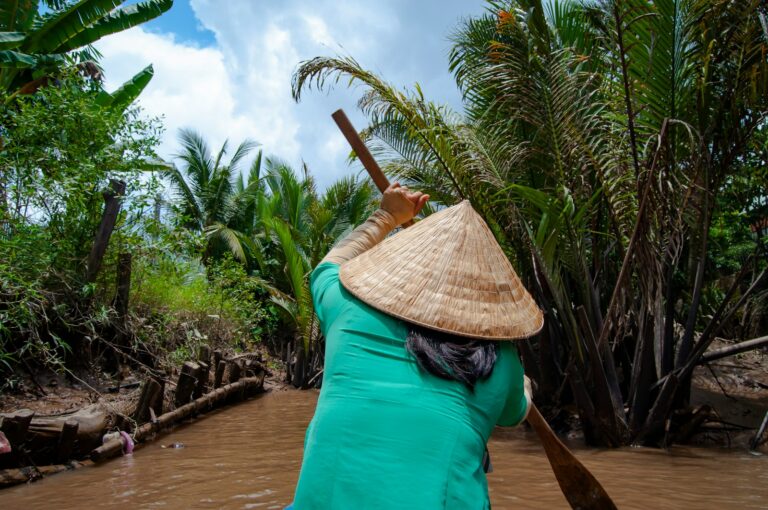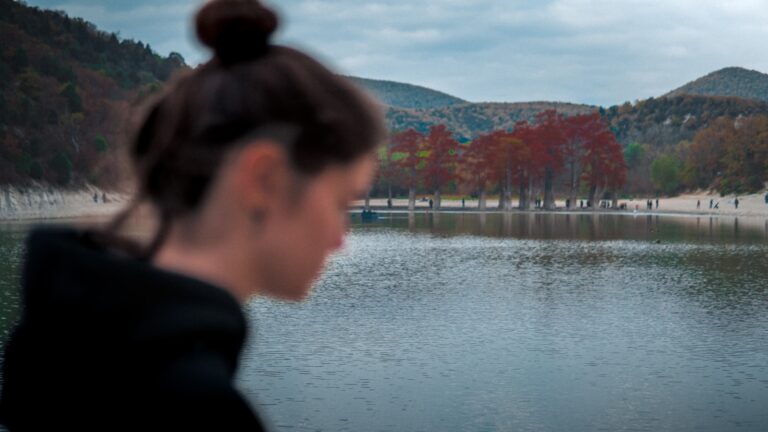Chiang Mai’s Ancient Walls: Where History Whispers
Late fall and winter are the best seasons to visit Chiang Mai. The air turns cool and refreshing, and flowers explode into bloom—it’s absolutely stunning. Perched in Thailand’s northern mountains, Chiang Mai’s weather during this time is a lot like Dalat in Vietnam: crisp mornings hovering around 18 to 20 degrees Celsius. With limited time to explore everything the city offers, we headed straight to its heart—the Old City walls.
We left our hotel at 8 a.m., hopped into a tuk-tuk—Thailand’s iconic three-wheeled taxi, also popular in Laos and Cambodia, usually carrying two passengers—and set off for the ancient walls. One friend in our group said the scene reminded her of Hue’s Imperial Citadel, though it was clearly smaller in scale. Unlike Hue’s largely intact fortress, Chiang Mai’s walls exist mostly as fragments—weathered pieces that hint at past glory.
The tallest surviving section stands about four meters high, made of strong red fired brick. A narrow moat runs alongside, once a key defensive feature. These days, both the wall and the moat neatly split Chiang Mai into its historic core and its ever-expanding modern sprawl.
The Fleeting Nature of Kingdoms
Near one wall section, we saw a portrait of the King of Thailand, decorated with birthday wishes—December 5 is also Thailand’s Father’s Day. Being at an ancient site like this always invites reflection on the impermanence of kingdoms, and of human life. Nothing lasts forever. Some dynasties disappear entirely, others are remembered fondly, and a rare few survive, stripped of their past power but still honored.
Like people, kingdoms rise, shine, and eventually fade. What endures is the legacy they leave behind—the memory, the achievements, the spirit.
As we walked, a sense of calm washed over us. A large flock of pigeons—maybe a hundred or more—filled a small courtyard nearby. A man parked his scooter, scattered seeds, and quietly fed them. Around him, rows of bright potted plants added a splash of color. The birds barely noticed us, too absorbed in their breakfast.
Temples and Tuk-Tuks: The Chiang Mai Vibe
We strolled along the moat, crossed through a section of wall, and soon found ourselves at Dokkham Temple on Moon Muang Road. Chiang Mai, like most Thai cities, is full of golden temples. You bump into one every few blocks.
Dokkham Temple faces east, and the morning sun lit up its golden roof with a warm, glowing light. Outside, a standing Buddha statue flanked by two guardian deities welcomed visitors. The temple wasn’t massive, but its architecture stood out—tiered roofs stacked high, crowned with serpentine creatures known as Nagas.
Nagas, common in Theravada Buddhist architecture across Southeast Asia, often sit on temple eaves to ward off evil. In Thai mythology, they’re also rain deities believed to protect temples from fire.
The temple doors were elaborately carved and painted in shimmering gold. It’s clear Thais treasure wood carving; even the window shutters carried the same ornate style. Inside the grounds stood moss-covered stupas, including a tall central spire ringed by smaller ones. These spiraled stupas—wide at the base and tapering upward—are a signature of Thai religious design.
After Dokkham, we wandered alongside the wall again and soon reached a lively street filled with foreigners. Definitely a backpacker hub. Everything was in English—signs, menus, even flyers for tours and trekking adventures.
This stretch of the city also had plenty of motorbike rental shops, not unlike Pham Ngu Lao Street in Ho Chi Minh City. We chatted briefly with a rental guy, who told us prices ranged from 200 to 500 baht, depending on the motorbike’s engine—about 5.50 to 14 U.S. dollars at current rates.
Nearby, a couple of red songthaews—shared pickup taxis—waited for passengers. These trucks take people to train stations, airports, or tourist spots like elephant sanctuaries, orchid farms, or snake shows. Each can carry around 8 to 10 people.
Whispers of the Past and a Surprise Pho
After leaving the backpacker street, we followed the moat again. Before long, another temple emerged. Across from it, a less-restored section of wall stretched upward. A narrow, slightly wild path flanked by sprinklers led to what looked like a low hill topped by the ruins of an old watchtower. A nearby sign offered some fascinating archaeological notes.
According to the sign, this was the Sri Phum Corner, the birthplace of Chiang Mai under King Mangrai. Later kings built and rebuilt the walls. King Muang Kaeo reconstructed them in brick in the early 1500s. In the 1790s, King Kawila renovated the walls again. An excavation in 1996 uncovered two wall sections and a mysterious layer of charred black soil, thought to be part of the original structure.
Another sign mentioned that this used to be the Nongpua area. A reservoir called Nong Wai once stood here, making it a thriving part of old Chiang Mai.
Soon we arrived at Chang Phuak Gate. The wall here was fragmented and unrestored, with the ancient city core now blending into modern residential neighborhoods.
Then came another temple—Quankama. Once again, we were greeted by the familiar image of Nagas guarding carved doors, golden Buddha statues, and towering stupas shining in the sun.
Right outside the temple gate was a small massage shop offering Thai traditional massage—120 baht an hour, or about 3.30 U.S. dollars. Same price whether for feet or a full-body rub. It’s a uniquely Thai thing: some temples include massage services on site. Clearly, locals appreciate the value of relaxation.
The “Pho Ga” Mystery Alley
Just past the temple, a sign reading “Vietnamese Food” pointed into a narrow alley not even two meters wide. Curious, we followed it and discovered a tiny restaurant boldly named “Phở Gà”—Vietnamese Chicken Pho. It wasn’t open yet, as it was still morning. The owner and staff were prepping food. The owner greeted us with a polite smile and a few words of English, but neither he nor his wife spoke Vietnamese. His staff didn’t speak English either. We all just exchanged warm smiles.
The menu, written in Thai, had photos: stir-fried noodles, mixed salads, spring rolls, crab fried rice, shrimp and pork dishes. Everything looked tasty and affordable, ranging from 25 to 140 baht—less than four U.S. dollars. The funny twist? Despite the big “Chicken Pho” sign, there was no pho on the menu at all. Just fried dishes. We left amused, laughing as we passed yet another ruined wall and finally exited the Old City.
The Enduring Charm
Chiang Mai’s ancient walls may be in fragments, but they still hold power. They give the city a feeling of timelessness, of history you can reach out and touch. In some places, the ruins almost look curated: a half-meter stretch of bricks here, one meter there, then a jump to 1.5 meters—like an artistic installation rather than a restoration.
The walls may not match the scale of Hue’s Imperial Citadel, and the scenery may not quite equal Dalat’s misty pine hills. But here’s the thing—Thailand has mastered tourism. They know how to showcase what they have, especially culture and history. The Old City walls are just one example.
Thailand’s Tourism Authority often invites foreign tour operators, journalists, and airlines to explore and share their experiences—an effective, low-cost way to promote the country.
Thai tourism is known for its quality. Locals working in tourism understand how to leave an impression, appealing to all five senses—and the heart. They believe that the first impression lasts forever. And in Chiang Mai, those ancient walls, crumbling but proud, leave an impression that lingers long after you’ve left.




